Adams National Historic Park
Thursday, November 2, 2006Ever since I read David McCullough's excellent biography of John Adams, I’ve wanted to visit his home place in Quincy, Mass. After we had shifted our campground south to near Cape Cod, I think Denise was rather puzzled why I insisted on heading back toward Boston and its traffic on a rainy Thursday.
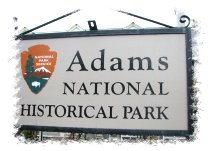
We were both glad we did, because the Adams National Historic Park is well worth a visit. The Adams family is one of the most significant political dynasties in American history, with their political career stretching over 4 generations (6, if you include ancestors of Abigail Adams). No where else in the U.S. can you view the birthplaces and graves of two American Presidents sitting side by side.
The park consists of 13 acres, including the Visitors Center in downtown Quincy, two modest saltbox homes sitting side by side where John Adams (our 2nd President), and his son John Quincy Adams (our 6th President), were born, and the large home where John and Abigail Adams purchased upon his return from Europe after the American Revolution. In this home (Peace Fields), 4 generations of Adams lived:
- 1st - John & Abigail Adams
- 2nd - John Quincy & Louisa Catherine Adams
- 3rd - Charles Frances and Abigail Adams
- 4th -Henry Adams, Brooks and Evelyn Adams
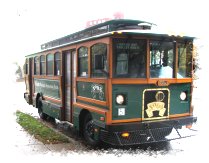
For a modest fee, the park offers a 2 hour guided tour of the properties, including a trolley ride between the sites. Vance collected the workbook for the Jr. Ranger program (this one was fairly extensive), and we hopped on the trolley for our tour.
The tour does an excellent job of highlighting the accomplishments of all 4 generations of this remarkable family.
Although John Adams only served one term as President, losing in a contested election to Thomas Jefferson, he is a giant of the American Revolution. Adams is overshadowed by Washington and Jefferson, but he is a key figure in our fight for independence. 2nd cousin to Sam Adams, and a cousin by marriage to John Hancock, he was well connected, and was considered one of the finest legal minds in the country. Although not well liked by many, and in possession of an abrasive personality, he was a gifted speaker and writer. He was the primary author of the Massachusetts constitution, a document containing many of the ideas later adopted in the US Constitution, and used as a basis for the New York, New Jersey, Virginia and North Carolina state constitutions. It is the oldest constitution still in use today in the world.
Adams along with Ben Franklin and Thomas Jefferson were appointed to a committee to draft the Declaration of Independence. Recognizing Jefferson’s brilliance at writing, the other two men coached Jefferson through the creation of the document. Jefferson became somewhat of a protégé of Adam’s, and they developed a close friendship. This friendship would last until Adam’s presidency, when with significant justification Adams felt that Jefferson was backstabbing him politically and personally. Relations between the two men became strained, and were only patched up later in life when they started a remarkable correspondence that continued until both men died on the same day. Amazingly enough, both Adams and Jefferson died on July 4, 1926 – the fiftieth anniversary of the signing of the Declaration of Independence.
John Quincy Adams grew up as a child prodigy. He joined his father in Europe at the age of ten while John Adams was petitioning France and the Netherlands to support the American side with loans and arms during the Revolution, an effort that ultimately proved both successful and critical to the outcome of the war. John Quincy served as his father’s personal secretary, and at the age of 15 traveled to Russia to serve as the translator for the Russian ambassador. Speaking 7 languages, John Quincy served as Ambassador to the Netherlands under James Monroe, Secretary of State, U.S. Senator, then as our 6th president.
In a bit of historical irony, John Quincy Adam’s election to the Presidency, as the son of another president, was a contested election. Similar to George W. Bush’s first election, Adams received fewer popular votes than Andrew Jackson (much like Bush vs. Al Gore), but tied in the Electoral College vote. The decision was thrown into the House of Representatives, where Adams was elected. This method of election largely hamstrung Adams presidency, and he was defeated by Jackson for reelection.
Adams later was elected to the House of Representatives, becoming the first and only president to serve in a federal elected office after his term as president. Adams served in the House for 17 years, and suffered a fatal stroke while delivering a speech in the House chambers. Adams successfully represented the slaves of the ship Amistad before the Supreme Court, winning their freedom. He was also mentioned in John F. Kennedy’s book, “Profiles in Courage” for his opposition to the Gag Rule, which prevented debate on the slave issue in Congress.
Charles Frances Adams, John Quincy’s son, was a one time vice presidential candidate, served in the House of Representatives, and was the ambassador to England during the Civil War. During this time his efforts were crucial to convincing England and France to remain neutral. He is credited by some historians as playing a role just behind Lincoln's and Grant’s in winning the war.
Henry and Brooks Adams, both sons of Charles Frances, served as advisors to Teddy Roosevelt. Henry Adams was a noted historian of American history.
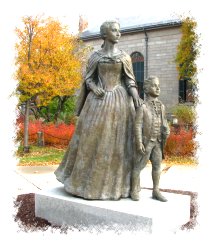
The ladies aren’t left out either. Abigail Adams was a remarkable woman whose correspondence to her much absent husband provides us today with a view into one of America’s great love affairs. Her and John were married for 54 years, and after her death, John refused to ever enter their bedroom where she had died, writing to Jefferson that he had lost the love of his life. Alone in their home just outside Boston for most of the Revolution, her letters provided valuable insight into the fighting and political landscape for her husband- first absent at the Continental Congresses, later overseas in Europe. She was the first ‘first lady’ to occupy the White House, and an early feminist. She famously instructed John ‘not to forget the ladies when drafting his new laws’, and stating ‘women also knew how to rebel, and would if forced to bend completely to men’s will’ in the new system.
Louisa Catherine Adams, wife of John Quincy, was our only foreign born first lady (England). Enormously popular, she received the honor of a 3 day shutdown of the federal government when she died, and a state funeral.
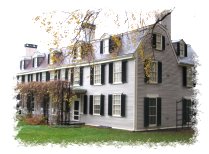
Back to the tour – the second stop was very interesting. John Adams called this house ‘Peace Fields’. It’s a fascinating house, and I say that as someone who is usually bored silly touring old homes. The furniture is original, and Brooks Adams arraigned for something from each of the 4 generations to be in each room. It’s hard to say exactly what made the house so interesting, but it was – even without the history and the artifacts, the house alone would be worth viewing. But seeing the chair John Adams had his fatal stroke in, viewing his walking cane, Abigail’s china, etc….it’s almost breathtaking.
Interesting side note – Most everyone pronounces John Quincy Adams as “Quinn-See”. It’s not – it is correctly pronounced “Quinn- zy”. The town of Quincy is pronounced likewise, as it’s named after his great-grandfather.
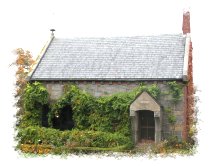
The other building on the tour is the Old Stone Library, located beside the house. The granite building, built from granite quarried from property owned by the Adams, was built from designs created by John Quincy Adams. His son, Charles Frances, had the library constructed after John Quincy’s death to hold his books and papers. Unofficially, it’s the oldest and smallest Presidential library in the country (F.D.R.’s is the first ‘official’ presidential library).
John, Abigail, John Quincy and Louisa Catherine are all interred in a crypt in the nearby First Parish Church. Today, this is a Universal Unitarian Church, a descendent of the Congregationalist Church where John Quincy Adams was a member. Both Adams were originally buried across the street in the Hancock cemetery. The crypt was constructed at the request of John Quincy Adams after John and Abigail died. Upon John Quincy’s death, his son Charles Frances requested that John Quincy and his mother be interred there, also.
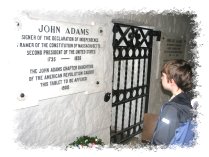
Creating one of those ‘Oh S**** moments, when John Quincy Adams was reinterred in his new tomb under the church, the coffin wouldn’t fit due to the ornamentation on the casket. He suffered the indignity of being stored in the church balcony until stoneworkers could carve out the additional space in the heavy granite walls of the tomb!
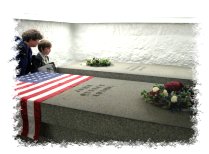
The crypt, underneath the church, is open to the public via tour. We were able to walk amidst the 4 granite tombs, with the two Presidents and their First Ladies lying side by side. It’s a sobering sight. We were fortunate enough to visit the tomb just a couple of days after John Adams’ birthday. In a tradition started by Lyndon Johnson, each former president receives a wreath on his birthday from the current president. John Adams is considered the father of the U.S. Navy, and J.Q. Adams helped found the Naval Academy, so the Navy handles the presentation of the wreaths to the two former presidents in a formal ceremony. John Adams’ wreath from President Bush was lying on his tomb, and Denise was allowed to take a carnation from the wreath by the staff.
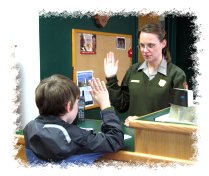
Back up in daylight, Vance finished up his Jr. Ranger activities, and was awarded the badge for this site. I was encouraged with how well he worked on the answers, and the questions he asked the rangers. I have cut back on his normal curriculum while we are in the Boston area, in order for us to spend more time on the history of the area, particularly since the time changed and it becomes dark around 4:45pm. I’ve been pleased with how well he has responded to this method of learning.
He was only required to do 5 activities to get the badge, but he did 8 of them without complaint. Vance was complimented by the Ranger on how well he did on his answers. I feel he is really getting a good grasp on the American Revolution period, in no small part by visiting many of the sites where the action occurred. We ended up the day by viewing a couple of episodes of the PBS series ‘Liberty’ at the Visitors Center, which covered the events leading up to the American Revolution. This was a perfect refresher for the various locations we had visited over the prior couple of weeks – Boston’s Freedom Trail, Lexington and Concord, Bunker Hill, etc…

Vance: Adams National Historic Park taught me a lot about our second and sixth presidents. The first house we went to was John Adams birth place. His father, Deacon John, made a living by making leather. When John Adams was president, he and his wife got lost on their way to the White House.
John Quincy Adams was born on July 11, 1767 in the house just next door to John Adam’s birthplace. When the Adams family returned from London, they never went back to Quincy’s birthplace. They moved a few blocks down the road. The house they moved into was called the Old House. Upstairs was a picture of General Warren dying at the battle of Bunker Hill. Next to the Old House was the John Quincy Adams Presidential Library. I got to open and close the smallest and the oldest Presidential Library in the Country!
P.S There was a video about the revolution that said John Hancock almost got chosen as head general instead of Washington!
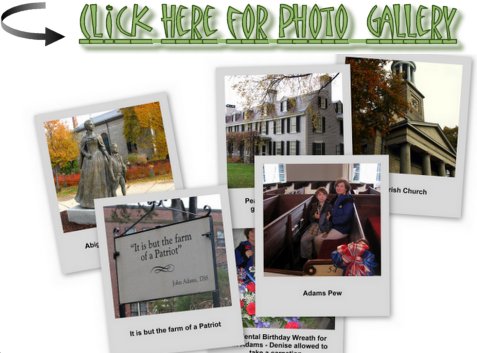







<< Home